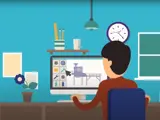The Sectors We Serve

Logistics
Transform logistics training with immersive simulations, enabling hands-on practice in warehouse operations, supply chain management, and route optimization. Our innovative training solutions can be used to drive efficiency, safety, and compliance.

Customer Service
Empower customer service teams with simulation-based training to offer them a hands-on way to practice handling diverse customer interactions and resolving complex scenarios. Improve customer satisfaction and retention by equipping agents with the skills and confidence to deliver exceptional service.

Aviation
Modernize aviation training with simulation-based learning to offer pilots, air traffic controllers, and ground crew realistic scenarios that they’ll encounter on the job. From flight operations to emergency procedures, immersive simulations ensure readiness and proficiency in every aspect of aviation.
Delivering Asynchronous Learning in a Demanding Industry
To properly serve their healthcare industry clients, it was critical for Canon Medical Systems to find a way to address their constant need to educate and train medical technologists whose schedules were often too demanding for on-site training. Due to high turnover and constant advancements in technology and regulations, training technologists, radiologists, and cardiologists had become an expensive and time-consuming process.
Canon Medical Systems partnered with SimTutor to find a solution to their training dilemma. By using SimTutor Author, Canon can now create customized simulation modules that can be completed anytime and anywhere. As technology and education requirements change, each module can be easily updated to ensure that all workers are getting the up-to-date hands-on training they need to excel in their roles.
How Can Simulation-Based Learning Transform Your Training?







